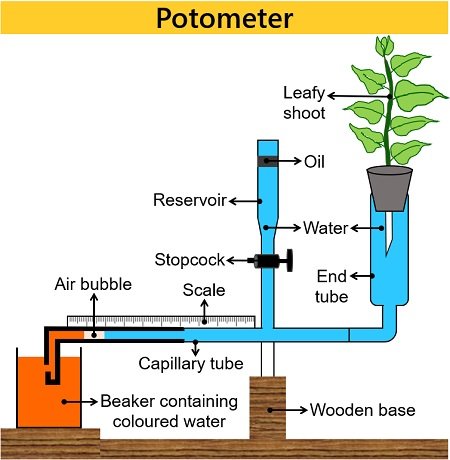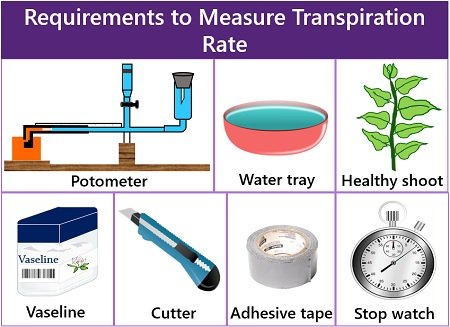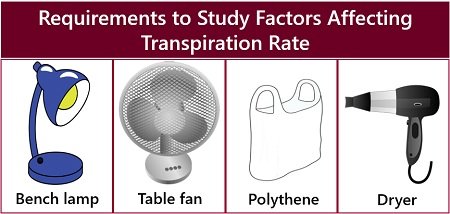A Potometer experiment is performed to estimate the transpiration rate in different plants. A potometer is an apparatus used to determine the transpiration rate of the cut shoot at the desired time. It is also called a transpirometer.
Using the potometer, we can record the readings of water uptaken by the cut shoot. There are two causes of water uptake. Plants uptake water to perform two major activities. One is transpiration, and the other is photosynthesis.
Transpiration is the evaporation of water by the leaves through the stomatal activity. Plants absorb sunlight, CO2 and H2O to give oxygen and carbohydrates during photosynthesis.
Thus, we can only get a rough idea about the transpiration rate using a potometer. But, the actual transpiration rate may be lower than the value indicated by the potometer. Because water loss can be due to both transpiration and photosynthesis.
Bubble and mass potometers are common devices used to measure transpiration in plants. A bubble potometer measures water absorbed by the shoot. Mass potometer measures the water loss by the shoot.
The working of a potometer depends upon the amount of water absorbed by the plant. This post discusses the purpose, design and working of the photometer. Also, the aim, requirements and steps are explained to measure transpiration using Ganong’s photometer.
Content: Potometer Experiment
- What is Potometer?
- Requirements of the Potometer Experiment
- Potometer Experiment Steps
- Factors Affecting Transpiration
- Calculation
- Precautions
- Advantages
- Limitations
- Conclusion
What is Potometer?
A potometer is a set-up that helps in estimating the transpiration rate and factors affecting transpiration. We can measure the transpiration rate in plants by knowing the amount of water absorbed by the plant. Here, the amount of water absorbed is equal to the water loss during the transpiration by plants. Also, we can study the effect of different external variables on transpiration rate.
What is the Purpose of the Potometer?
A potometer aims to measure the water absorbed by the plant, which is equal to the value of transpiration.
What is the Design of the Potometer?
Potometers are available in a variety of designs. But all follow the same basic principle and comprise of the following components:

- Capillary tube: Here, a bubble travels a distance due to water absorption by the plant. We can measure water uptake through regular gradations on the tube.
- Reservoir: It is like a funnel with a tap. We can reset the bubble by turning on the tap. Some potometers also use a syringe in place of a reservoir.
- End tube: It holds the shoot. The stem end must be in touch with the water. Additionally, we need to fix the cork Bauer on the end tube to avoid air bubbles.
How does a Potometer Work?
There are two main types of potometers.
- In a bubble photometer, we require a leafy shoot fixed within the end tube. Then, over a specific time, an air bubble travels a distance that is equal to the water uptaken by plants.
- In a mass photometer, we require a plant with its root submerged in a beaker. This beaker is then placed on a digital balance. Readings depend upon the amount of water lost by the plant.
Thus, we can measure transpiration by recording the change in the volume of water taken up or the change in mass.
Requirements of the Potometer Experiment
To study the transpiration rate, we need:

- Potometer to conduct the experiment and to take out the readings.
- Water bucket to submerge the apparatus.
- Healthy shoot to study the rate of transpiration.
- Vaseline seals all the connection points.
- Cutter cuts the shoot.
- Adhesive tape secures the airtight seal.
- Stopwatch is used to set the time.
To study factors affecting the rate of transpiration, we can use:

- Bench lamp to know the effect of light intensity.
- Table fan to know the effect of wind speed.
- Polythene to know the effect of humidity.
- Dryer to study the effect of temperature.
Potometer Experiment Steps
- First, submerge the whole apparatus in the sink or water tray to remove air bubbles.
- Then, cut the plant shoot underwater and insert it into the hole of the cork Bauer fixed to the end tube. This step should be quick to avoid entering any air into the plant’s xylem.
- After that, attach the whole unit to the capillary tube underwater.
- Then, use vaseline at all the connections to ensure an airtight environment. Also, we could use adhesive tape to secure the airtight seal.
- After that, we can take out the potometer apparatus and mount it on the wooden base.
Note: If any bubbles appear, restart the whole procedure to get accurate results. - Then, place the open end of the capillary tube into a beaker. The capillary tube has graduations in millimetres.
- Add colour to the water to see the distance travelled by the air bubble within the capillary tube.
- Introduce an air bubble by dipping the capillary tube out of and back into the beaker containing water.
- Note down the distance of an air bubble before the experiment. Then set the time in the stopwatch. Allow the air bubble to move at a given time.
- Finally, record the reading by looking at the distance an air bubble moved.
- We can also repeat the experiment by refilling the system by turning the glass stop cock. During this stage, we can reset or adjust the air bubble.
Factors Affecting Transpiration
We can also investigate the transpiration rate under different environmental factors. Below, we will discuss the effect of different variables on transpiration.
Light Intensity
We can study the effect of light intensity by using a bench lamp at different distances. High light intensity causes turgidity of guard cells, allowing stomatal opening. It permits more water loss.
Wind Speed
To know the effect of wind speed on transpiration, we can use a table fan. By using an inch tape, we could place the fan at different distances to study the effect of high and low wing speed. More wind speed removes water vapour from the air surrounding the leaf. Thus, it generates a steep concentration gradient between the leaf and water. It leads to an increase in water loss or transpiration.
Humidity
We can wrap a polythene bag around the leaves to know how the humidity affects transpiration. When the humidity is high, the air concentration saturated with water vapour is high. As a result, the diffusion of water vapour from the leaves reduces. Here, the concentration gradient is smaller, resulting in a less net flow of water vapours.
Temperature
To know how the temperature affects transpiration, we can use a dryer. Higher temperature increases the water molecules’ kinetic energy, resulting in high transpiration rate. Water molecules evaporate from the mesophyll and diffuse away faster.
How does a potometer measure transpiration?
Calculation: The transpiration rate is equal to the distance that an air bubble moved within the capillary tube at a given time. The transpiration rate is measured in ml/min or cm/min.

Using a potometer, we could estimate the transpiration rate in two ways:
- Indirect Method: Here, we need to measure the reduction in the volume of water in the capillary tube over some time.
- Direct Method: Here, we need to measure the loss in mass of the potometer over some time.
Precautions
- Plant shoot must be fresh and healthy.
- The whole apparatus must be airtight.
- The cut stem must be fixed to the end tube underwater.
- Leaves of the desired shoot must be dry before cutting.
- There should not be any air bubbles in the apparatus.
Advantages
- It measures the transpiration rate by estimating water uptake by the plant.
- It helps to study the effect of variables like light, humidity, temperature and wind speed on the transpiration rate.
Limitations
- It isn’t easy to set up, as an air bubble may alter the results.
- The potometer does not give accurate results. Because not all the water that the plant takes is used for transpiration. Plants may take water for photosynthesis or to maintain cell turgidity as well.
- The cut shoot does not remain active for a long time.
- The air temperature outside may change the position of the air bubble within the capillary tube.
Conclusion
Thus, a potometer is used to calculate the amount of water that the cut shoot has uptaken. The water uptake by the plant gives the value of water loss or transpiration rate in a given plant.